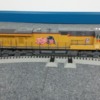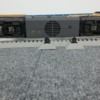I have posted a picture below that will hopefully explain where the "black hole" dead spot is occurring. In the picture it is between two switch tracks that are head to head or butt to butt, I'll let you decide, but it's where the switch lamp stands are located.
Take a look at the picture and you'll see an ES44AC MTH 2017 Union Pacific engine, then again, if BNSF were painted on it then it would be a BNSF engine, but hopefully to get te picture pardon the pun. It is photographed sitting dead on the track, dead meaning it got that far at 5 miles per hour (smph) and just stopped then shut down without any commands from me or the remote. I attempted some diagnostics.
I picked up the engine, moved it back to it's parking spot, started it up again, because at the spot it is pictured all I got was ENGINE NOT ON TRACK. Once restarted I did a signal test at 3 miles per hour. As the engine crept forward I saw 10,10,10,10,10,10, and when it reached said exact spot again, it went from 10 to dead. Not 10 to 1 or 10 to 2 or even 10 to 0, it just stopped and shutdown. Diagnostic 2. I sped up the engine to 8 miles per hour. From where it was parked, passed the dead zone, and on down the track I got consistent tens. At that point I ended the signal test, used reverse to my advantage, and brought it back to the parking track at 6 miles per hour. Tens across the board, including tens as it passed the black hole in reverse and parked itself, with my help and the DIR button. I did a voltage test at 8 miles per hour. Anywhere from 18 to 17.5 covering the same distance. I did a voltage test at 5 miles per hour. 18 to 17.9 until it reached the dead spot. Nothing. Went from 17 point something, 8 I think, to completely stopped and shut down. No extremely low voltage indication before it died.
Both switches work just fine. They open on command, close on command, and minus a dead bulb on one of them, the left hand one, they work fine when commanded to dance.
The engine is brand new. Maiden run last night right out of the box. Four other engines on my layout that actively run over that same spot every day at 5 to 55 miles per hour and never miss a beat. Problem first started with a DDA40X that I thought maybe the wide base between the trucks might be a cause. This is a 19 1/2 ES44AC Premier just like it's counter part a 2016 version BNSF. Same size, same length, same MTH. I do have a 2018 RJ Corman SD40-2 that experienced a dead spot at the top of the track oval. It did the same thing, stopped, shut down, sat 10 seconds, spontaneously started itself without my assistance, and reset all the defaults back to their original settings. I knew because the smoke generator was on again.
The DDA40X has had all kinds of dead spot issues. Even at 14 miles per hour it found one and shut down.
They only occur at areas of the track where multiple switch track are placed, and up to now, only three places where that occurs. One is in the photo, two is where RJ suddenly lost consciousness, and a third is near an area where I have four switches set up to move a train from track 3 to track 2 to track 1. Until DD stopped at 14, this poltergeist only showed itself when that particular engine was asked to navigate a switch or more specifically a set of switches at 5 or under miles per hour. Anything 8 or above seemed to solve the problem. A guy in Lexington told me it was due to "momentum". Not dispelling his expertise, and I thank him for the advise, but how can going faster over a bad spot cause the engine to successfully overcome the bad spot? To me that's like saying, if you walk into a wall, you'll hit the wall and break your face. If you run real fast you'll pass right through it. And I was upping the mph to 8, not 88.
The last scary moment in all this happened when I tried a final experiment. I ran the engine at 6 mph over the same space and when it stopped, I quickly dialed up the speed to 10 or 12. It didn't work. BUUUUUUUTTTT, my BNSF engine, which by the way was on the inactive list at the time, suddenly woke up ready to run, moved forward at a slow rate of speed quickly picking up speed and was nearly at 20 before I could ALL STOP it and avert disaster. Out of four inactive engines it picked that one, which by the way is number 1 on my list, UP is 2, and not only did it spontaneously start, but it took a life of its own and was running free of the remote. Thank goodness the remote was still talking to the TIU so E STOP worked.
Does anyone out there have a clue what could be causing these "black holes", "dead spots", you are free to call them something else if you like. But to answer a few questions I will probably get.
Yes I have read Barry's book.
Yes I did add booster wire drops to various parts of the ovals to increase and balance the voltage and signal readings.
I power my switches using the track not auxiliary power, but I did put chokes in each switch to help with that. If you aren't sure what a choke is, ask Gunrunner John.
All of my engines are 2016-2018 MTH Proto-sound 3
I use Fastrack
072 left and right hand switches
The problem areas use Remote switches, not remote/command
I power my track using a lionel brick, attached to one of the fixed IN ports on my TIU and thus I have 16 gauge wire running from that ports OUT port to a Terminal Board where I have an abomination of 18 gauge wires hooked together that feed the track.
My switches all work off two AIU's and the remote.
Up to now I have had little to no problems with "glitches" after I followed everyones advice in December and ran the booster wires.
Any help anyone can give me on this is greatly appreciated







